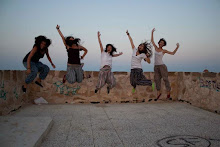Upon the first arrival
in Guardamar del Segura, it was glaringly obvious that this city was quite
different both structurally and culturally compared to the larger cities that
we had previously visited. However, the small-town vibes of Guardamar directly
impacted how the town participated in rituals and organized itself socially
through the structures of the town. Unlike Madrid, the plazas are not as
utilized in Guardamar in the same way. Groups of women gossip in the street,
leaning on lampposts, creating their own social plaza. Socialization is not
restricted to a specific area, as people chat in the streets, stopping in the
middle of the road, in bars, restaurants and along the beaches. In other
cities, it was rare to see clusters of people on the streets, chatting in
places other than parks and plazas. Guardamar del Segura, knowingly popular for
being a beach town, is mostly concentrated around the water. From the actual
beaches themselves to the restaurants that line the edge of the coast, at any
given time of the day, the entire town can be found near the water.
However, it is
interesting to consider how the definition of urban space shifts in the context
of different cities. For example, in Madrid, it was clear that life revolved
around plazas, whether they were stops along a journey or the final
destination. Guardamar is unique in this sense, as the urban space is focused
near the beach and the life that inhabits the area around it. Spatially, as one
moves away from the beach, it seems as life slowly fades away. The streets grow
empty and the silence takes over. The stark contrast between the day and the
night offers an interesting perspective on the population of Guardamar. Their
use of public space reflects their values as a group.
There is an apparent
shift to the urban fabric of Guardamar on Wednesdays, due to the weekly
Mercadillo. The streets are alive and loud in the early hours of the morning,
as casual passersby’s catch quick conversations with friends and strangers. The
Mercadillo transforms the space that it consumes. Standing at the edge of the
entrance, city streets, crosswalks, and plazas are simply absorbed into the
Mercadillo. Traces of a city remain, yet the streets are flooded with stalls
and people. Street signs are hidden reminders of what used to be. Tall
buildings emerge from the mass of stalls, peeping through the ocean of people.
Like a raging river, the Mercadillo flows through and after a few hours, leaves
no trace of its existence. Customers flow in through shops, some looking for a
specific destination, others simply browsing through the Mercadillo. Strangers
and friends, alike, come together at the Mercadillo, as one. Hues of blue shine
through the awnings draped over the stalls. They cast a dewy shade over the
market, reflecting like the ocean on the faces of the passerbys. The sky peeks
through the drapes, spotted white clouds contrasting from the blue. Flashes of
what used to remain are visible to the trained eye. To others, the Mercadillo
is a blur, where all the stalls seem to look the same. Pushed aside by old
Spanish ladies with carts, a stranger is forced to simply move with the flow of
the market. Customers walk in through the market in waves, some streets busier
than others. Sidewalks disappear beneath the wheels and shoes of people zooming
by. Skies are hidden by tarps, providing comfort from the harsh glare of the
sun. Clothes hang from the stalls, flags that tempt customers to enter their
stalls. With each turn is a flood of bright and extravagant colors, yet somehow,
each street is unique in its own sense. The Mercadillo as a whole survives as
an entity, yet each of its components is truly unique. At the end of the day,
tarps slowly sink to the floor, disrupting the barrier between the two worlds.
The streets begin to recover, returning back to their original state. Buildings
reappear amongst the chaos and the city returns.
- Neha Venkatesh
- Neha Venkatesh

No comments:
Post a Comment